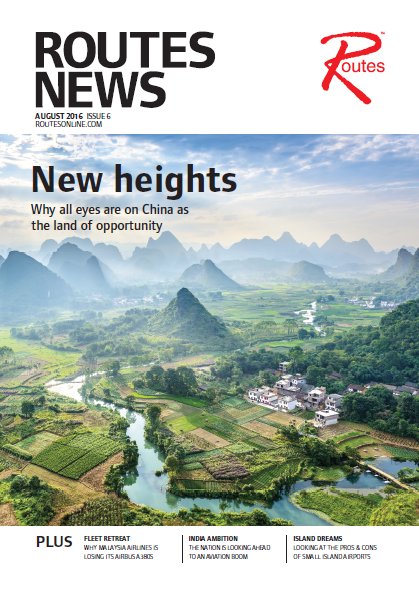The Asia-Pacific region is already the number one aviation market in the world and its dominance is only going to grow in the next couple of decades – driven mainly by the huge expansion in air travel within China.
Asia currently accounts for about 31.5% of all global passenger traffic, ahead of Europe (26.7%) and North America (24.7%), according to the latest figures from the International Air Transport Association (IATA). In the first six months of the year, traffic in Asia grew by 8.4% - well ahead of the global average of 6%.
The Chinese domestic passenger market is now the third biggest in the world, behind internal US traffic and the intra- European market. During the first half of 2016, Chinese domestic travel jumped up by 9.8% compared to the same period last year, due to higher consumer spending and increased routes within China.
This trend is only set to continue, with Boeing predicting that Asia will account for around 49% of global passenger traffic by 2035. The region’s traffic is set to rise by 6% per year over this period, equating to 100 million new passengers every year.
To cope with demand, Boeing is forecasting that the number of aircraft in service across Asia will have to nearly triple from the 6,350 flying last year to 16,970 by 2035. Fast-growing low-cost carriers (LCCs) will buy an estimated 11,000 single-aisle aircraft in the next 20 years, while there will also be demand for around 3,700 new wide-body long-haul aircraft.
Aviation consultant John Strickland, of JLS Consulting, said: “There is a massive number of aircraft on order which are going to come through in the next few years – largely led by LCCs. The legacy airlines are wrestling with this growing competition and amount of capacity.”
While this projected increase is being primarily driven by China’s economic growth, there is plenty going on in other parts of the region, including south-east Asia, which should benefit from a new “open skies” agreement.
Patrick Folley, a director at aviation consultancy Consilium, added: “Airlines would not be in a position to take on these significant numbers of aircraft if they didn’t have the routes to fly them on, and increased market liberalisation across the Asia-Pacific region has opened up considerable new opportunities.”
Despite the rise in regional passenger traffic, airlines in south-east Asia continue to experience low profit levels – with an average operating profit margin of just 0.3%, according to IATA. This is the worst financial performance in the world, apart from the loss-making African aviation industry.
Airlines’ bottom lines have been continually squeezed by intense competition within the region from LCCs, such as AirAsia and Lion Air, which is only going to intensify with both these carriers having more than 400 aircraft on order. The long-haul market has also been affected by the aggressive expansion into Asia of the major Gulf carriers: Emirates, Etihad Airways and Qatar Airways. Even the drop in oil prices has not proved to be such an advantage for airlines as it has been accompanied by a rise in the value of the US dollar, which the carriers have to use to pay for their fuel.
South-east Asia’s fastest-growing market is Indonesia, which has been adding airline capacity at an average annual rate of around 15% for the last 10 years. The strong growth has come as the country has overcome a fearful reputation for aircraft safety – change led by the LCC Lion Air and the once-derided flag-carrier Garuda. However, growth has slowed so far in 2016 – passenger numbers only rose by 2.3% in the first half of the year.
Garuda has added new domestic routes from its Jakarta hub to Sumatra and Borneo this year, as well as relaunching its Singapore to Medan route and adding a Jakarta-Medina, Saudi Arabia, service. But its most significant international move has been switching its UK flights from Gatwick to Heathrow, which has allowed it to offer the first non-stop direct flight from London to Jakarta.
“Our long-term strategy from 2016– 2020 focuses on network expansion by 2018, optimising Garuda’s business in Asia Pacific by serving new potential destinations,” said Benny Butarbutar, Garuda’s VP of corporate communications. “Since Indonesian authorities have been upgraded to a Category 1 safety rating with the Federal Aviation Administration (FAA), Garuda Indonesia plans to re-explore the feasibility of starting flights to the US in 2017.”
If Indonesian airlines are set to benefit from the country’s upgraded safety rating, it is a different story for Thailand’s aviation industry. Both the International Civil Aviation Organisation (ICAO) and the FAA in the US last year downgraded its safety rating for Thai-based carriers from Category 1 to Category 2, for failing to comply with international standards.
This has held back the international growth of new airline NokScoot, a low-cost joint venture between Thailand’s Nok Air and Singapore Airlines’ Scoot that started flying last year. Thai Airways also wants to reintroduce flights to the US from Bangkok next year after axing them in 2015. But this move depends on the ICAO and FAA upgrading their safety rating for Thailand.
In neighbouring Malaysia, the headlines have been dominated by the woes of flag-carrier Malaysia Airlines following the loss of two aircraft (MH370 and MH17) in 2014. It also underwent a major financial restructuring last year.
The airline has been concentrating on a regional strategy to rebuild its business with a focus on China. Malaysia ordered 50 Boeing 737-MAX aircraft in July, and will also start receiving six Airbus A350s from 2017, which are set to replace the A380 superjumbo on its route to London. Malaysia has also been cutting capacity – a move that low-cost rival AirAsia has capitalised on, with strong growth in Malaysian traffic helping AirAsia to record a 12% rise in passenger numbers to 13.9 million during the second quarter of 2016.
AirAsia, which also operates in Thailand, India, Indonesia and the Philippines, could resume long-haul flights to Europe after a four-year gap. The carrier had advertised on its website a daily service from Kuala Lumpur to Barcelona, via Istanbul, from October 30. But consultant Strickland is not convinced: “I will be very surprised if AirAsia comes back into Europe now as they don’t currently have a particularly suitable fleet for these ultra-long-haul sectors.”
While the low-cost revolution has been in full swing in south-east Asia, this has not been so true in the north-eastern part of the continent, including Japan, South Korea and Taiwan, where LCC penetration is only around 11% of capacity compared with 56% in south-east Asia. Although some LCCs, such as Korea’s Jin Air and Jeju Air, have much larger proportions of some key markets (such as Korean domestic and Japan-Korea traffic).
Chris Crampton, UK chairman of PATA, said: “It’s open skies that would make the biggest difference. The Association of Southeast Asian Nations (ASEAN) countries have it, and you’ve seen the proliferation of LCCs across the region – you don’t have it elsewhere on the continent. There’s quite a contrast between that part of Asia and elsewhere.”
Some airlines, most notably Japan’s All Nippon Airways and Japan Airlines, have been able to steal a march on competitors by becoming early users of the Boeing 787 Dreamliner. This has allowed them to develop more long-haul routes and increase frequencies, despite initial technical problems with the aircraft that led to the grounding of the entire worldwide fleet for three months in 2013.
Talking of Dreamliners, Korean Air is due to add the 787-9 to its fleet in 2017. It is also launching flights from Seoul to Delhi in December, as well as adding a route to Okinawa, its 16th destination in Japan. Meanwhile, Korean is considering a new route to Iran – it has already been granted permission to operate four weekly flights between its Incheon hub and Tehran. But weak demand has led to the suspension of its service to Sao Paulo in Brazil following the Olympics.
Elsewhere Hong Kong’s Cathay Pacific has rebranded its sister regional airline Dragonair as Cathay Dragon, and added new routes to Madrid and from London’s Gatwick Airport, which is being served by its new Airbus A350 fleet. “The A350 fleet makes it feasible for Cathay Pacific to launch and operate direct flights to second-tiered destinations in Europe, further expanding our global network connectivity,” said Paul Cruttenden, marketing and digital sales manager for Cathay Pacific.
Taiwan’s EVA Air is also expanding its long-haul network by adding Istanbul and Chicago as destinations from Taipei, while frequencies have been increased to Brisbane and Paris. With all this growth, airports are struggling to keep up with demand. Consilium’s Folley added: “Airport capacity and regulation are the two biggest barriers to growth. With the strong growth in traffic in the region, airport infrastructure has struggled to keep pace.
“Growth across the region is such that all areas are in need of more capacity if they are to meet growth forecasts, although some - such as Japan - are more mature than others. China and ASEAN are the areas with the strongest growth prospects and the greatest need for more capacity,” he adds.
Creaking airport infrastructure is one of the main reasons why the region’s airlines have been ordering larger aircraft to help to continue growing traffic into some of the most congested Asian hub airports.
 |
This article is modified from an original feature that appeared in... ROUTES NEWS - ISSUE 6, 2016 PLEASE CLICK HERE to view the magazine. |
 |





